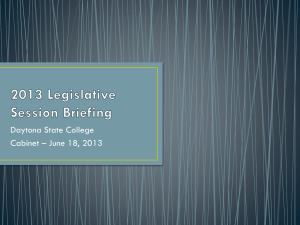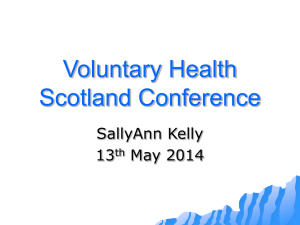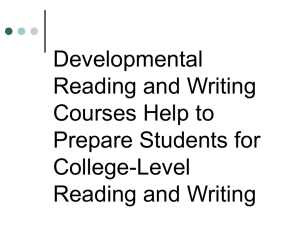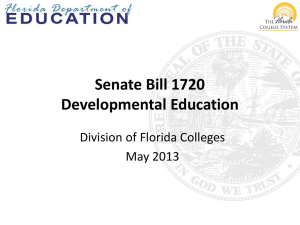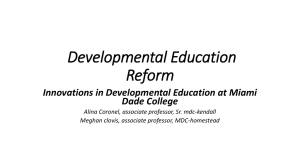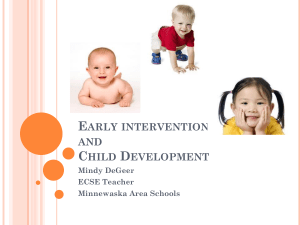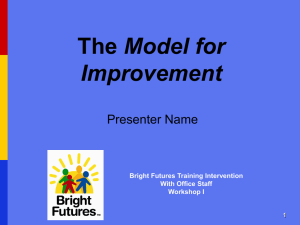Assessment of Developmental Education Programs
advertisement
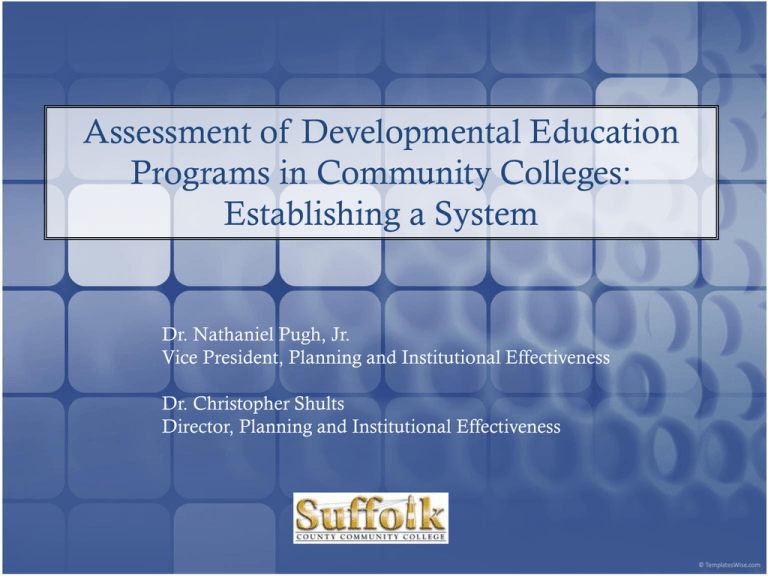
Assessment of Developmental Education Programs in Community Colleges: Establishing a System Dr. Nathaniel Pugh, Jr. Vice President, Planning and Institutional Effectiveness Dr. Christopher Shults Director, Planning and Institutional Effectiveness Table of Contents The Status of Developmental Education Developmental Education in SUNY and at SCCC Developmental Education and the SCCC Institutional Effectiveness Model Progress in Establishing Developmental Assessment Q&A Developmental Education Nationally Developmental Education is not new (UW in 1879) Massive expansion by the turn of the century Massification of higher education as a result of the GI Bill Granted access to higher education to groups historically left out Levin 2001 – Legal and social mandate Stigma increased based on two issues Economic conditions Student success concerns (nearly 50% nationally – higher in community colleges) State studies (TX, OH, FL) show lower success rates Differential policies on remedial course-taking Percentage taking developmental courses has nearly doubled since 2000 Developmental Education in SUNY Developmental education in SUNY limited to community colleges 2006 system-wide study 37.5% of first-time freshmen were enrolled in developmental coursework in 2004 More than ½ of the colleges saw increases Percentages have increased dramatically and reflect national averages Developmental Education at Suffolk Nearly 27,000 students From 2,246 to 3,448 entering first-time freshman taking at least one developmental course from fall 2005-2010 An increase from 58 to 64 percent between fall 2005 and fall 2010 In fall 2008, 4,000 seats to developmental studies In academic year 2010-2011, 500 sections and more than 7,000 seats “We still do not know very much about the actual success of remedial programs because colleges do not evaluate them very well. They frequently collect inappropriate or poor-quality data and use inappropriate criteria for measuring effectiveness…[the fact is] they do not know how to assess it” (Roueche & Roueche, 1999, p. 27 as cited in Romano, 2006). Inside the Numbers at SCCC Institutional effectiveness has been operationalized at Suffolk County Community College as “the ability of an institution to achieve its stated mission and goals. Given that SCCC, like nearly all colleges mentions student success, to one degree or another, it was decided that we must examine what impact developmental studies is having on our institutional effectiveness efforts. Inside the Numbers Continued New Students Testing into Developmental Courses by Subject Fall 2006-2010 Full-Time Fall 2006 Fall 2007 Fall 2008 Fall 2009 Fall 2010 Part-Time Fall 2006 Fall 2007 Fall 2008 Fall 2009 Fall 2010 Total Fall 2006 Fall 2007 Fall 2008 Fall 2009 Fall 2010 N 4152 4340 5058 5074 5487 1128 1054 806 1675 2799 5280 5394 5864 6749 8286 Writing Percent 21.1% 26.1% 28.0% 31.2% 31.0% 15.8% 18.5% 30.6% 19.3% 10.6% 19.9% 24.6% 28.3% 28.3% 24.1% Math Percent 44.0% 46.0% 46.8% 56.5% 53.1% 34.2% 36.8% 54.0% 35.0% 21.4% 41.9% 44.2% 47.8% 51.2% 42.4% Reading Percent 29.2% 32.6% 36.9% 39.7% 37.9% 18.4% 21.6% 34.2% 20.4% 12.3% 26.9% 30.5% 36.5% 34.9% 29.3% Inside the Numbers Continued Fall 2005 Cohort of Entering Freshmen, Fall 2008 Developmental Courses Required 0 1 2 3 N (3,862) 1,616 581 700 395 Graduation 26.4% 20.3% 13.9% 11.7% Transfer* 38.4% 31.0% 30.3% 22.6% Persistence 18.6% 20.3% 18.4% 23.3% Attrition 35.8% 42.5% 47.3% 51.4% % of DWFs in Gateway Courses 35.2% 40.4% 45.7% 47.3% Fall 2006 Cohort of Entering Freshmen, Fall 2009 Developmental Courses Required 0 1 2 3 N (4,074) 1,668 634 714 432 Graduation 23.0% 19.6% 12.3% 9.7% Transfer* 39.4% 30.0% 27.7% 17.8% * Transfer rates include graduates ** DWFI Findings are significant at .05 Persistence 17.6% 20.2% 21.0% 24.1% Attrition 37.0% 42.0% 48.0% 55.3% % of DWFs in Gateway Courses 35.2% 40.4% 43.0% 48.7% Inside the Numbers Continued Fall 2007 Cohort of Entering Freshmen, Fall 2010 Developmental Courses Required 0 1 2 3 N (4,274) 1,640 636 771 500 Graduation 22.2% 18.7% 12.9% 12.2% Transfer* 38.4% 28.9% 24.8% 20.2% Persistence 18.7% 19.0% 20.6% 22.8% Attrition 36.5% 44.3% 49.4% 52.2% % of DWFs in Gateway Courses 33.6% 39.9% 41.9% 43.7% Inside the Numbers Continued Persistence of New Associate Degree Students – 2nd through 4th Semester Fall 2006 No Developmental Developmental Total Fall 2007 No Developmental Developmental Total Fall 2008 No Developmental Developmental Total Fall 2009 No Developmental Developmental Total Semester of Enrollment First Second Third Fourth N Percent Percent Percent 2095 79.3% 64.7% 57.6% 2524 78.2% 61.7% 55.1% 4619 78.7% 63.1% 56.2% 2024 81.5% 65.2% 58.7% 2798 80.2% 63.7% 55.7% 4822 80.7% 64.3% 57.0% 2315 82.5% 69.7% 63.6% 3477 79.0% 65.3% 56.7% 5792 80.4% 67.1% 59.5% 1901 82.9% 69.3% 64.0% 3907 77.3% 60.0% 53.8% 5808 79.1% 63.1% 57.2% Pearson ChiSquare Tests Fall 2006 Fall 2007 Fall 2008 Fall 2009 Chi-square df Sig. Chi-square df Sig. Chi-square df Sig. Chi-square df Sig. Second 0.922 1 0.337 1.391 1 0.238 10.979 1 0.001* 24.079 1 .000* Semester Third 4.535 1 0.033* 1.253 1 0.263 12.207 1 .000* 47.855 1 .000* Fourth 3.006 1 0.083 4.389 1 0.036* 27.33 1 .000* 54.253 1 .000* Inside the Numbers Continued Transfer Rates for Students Taking at Least one Developmental Course Year 2006 2007 2008 2009 2010 Total Total # of Transfers who took at least transfers one developmental course 4019 1301 4204 1359 4327 1559 4466 1672 3275 1172 20291 7063 Percent of transfers who took at least one developmental course 32.4% 32.3% 36.0% 37.4% 35.8% 34.8% Given that around 60% of students take at least one developmental course, those taking developmental courses are less likely to transfer Inside the Numbers Continued Persistence Rates in STEM Programs by Developmental Course Taking: Fall 2006-2009 Fall 2006 No Developmental Developmental Fall 2007 No Developmental Developmental Fall 2008 No Developmental Developmental Fall 2009 No Developmental Developmental Semester of Enrollment First Second Third Fourth N Percent Percent Percent 199 83.9% 64.3% 55.8% 76 84.2% 71.1% 65.8% 168 85.7% 68.5% 64.3% 103 79.6% 62.1% 60.2% 186 88.2% 73.7% 63.4% 114 75.4% 69.3% 58.8% 161 85.1% 73.3% 68.3% 116 79.3% 60.3% 60.3% The persistence rates are higher for both categories with the only significant differences emerging in Fall 2009 Interpreting the Numbers Students taking any developmental courses are less successful Students taking between 1 and 3 developmental courses are equally successful The proportion of students taking developmental courses are increasing even as the population grows Students taking developmental courses are having a greater impact on overall measures of student success (higher proportion and greater numbers) We have the data, now what? Deploying a Comprehensive IE System at SCCC Ahead of the 2007 reaffirmation, Suffolk Community College began fully implementing a Comprehensive Assessment Plan for Institutional Effectiveness. This plan has resulted in information that has formalized and expanded assessment efforts and laid the foundation for an extensive and integrated planning system that will further enhance assessment activities and allow for expansion of the initial assessments in developmental education. Regardless of whether developmental education is a program or sequence of courses, assessment of learning outcomes will be conducted and the information will be used as part of the decision-making process. Planning Efforts and MSCHE Standards Strategic Planning The preeminent planning process Responsible for aligning college operations with external conditions Drives mission development/revision and creation of institutional goals (IGs) (Standard 1) Operational Planning Connected to strategic planning through the IGs Includes assessment of student learning and the environment for student learning (Standard 7,12, and 14 directly and 8,9,11, and 13 indirectly) The planning effort rooted in daily activities Budget Planning Connected to operational planning through resource allocation (Standards 2 and 3) Connects back to strategic planning through the IGs (Standards 2 and 3) SCCC Institutional Effectiveness Model – Gears and Cogs Academic Planning Use Results Plan OPERATIONS PLANNING Implement SWOT AES Planning State Budget Plan Plan Evaluate Use Results ASSESSMENT BBUDGETING UDGET Evaluate Budget Requests Stakeholder input Institutional Activities Major Planning Systems Assessment Efforts Institutional Effectiveness System Continuous Improvement Gear Movement Implement STRATEGIC PLANNING STRATEGY Implement Env. Scan Use Results Evaluate INSTITUTIONAL EFFECTIVENESS County Budget Assessment is at the Core Assessment and strategic planning Assessment and operational planning Assessment and budgeting Assessment of the IE system Assessment within an integrated system allows the college to move from data collection and information processing to informed and integrated planning that guides the evaluation of institutional effectiveness. The key is that information is evaluated for relevance and is filtered through systematic processes that link the institutional goals with resource allocation. Developmental Education Assessment and Operational Planning The SCCC Developmental Studies Advisory Committee Current course-based assessment in developmental math Connecting assessment in courses to the planning process (SLOs) Integration of developmental studies as part of academic planning Building up SLO assessment and program review in developmental studies Framework for Operational Planning in Developmental Education What’s Next at SCCC? Consensus that developmental studies needs more intensive assessment Consensus that current planning efforts need to continue evolving based on assessment of the IE system Intense discussions about the status of developmental studies – program or a sequence of courses? Assessment will be comprehensive whether as a program or sequence of courses Expansion of assessment activities in developmental English and reading Assessment of the impact of interventions (i.e. Title III, program changes) Increased focus on student success (CPT scores, placement, outcomes) Connecting developmental studies assessment into operational planning Questions?

